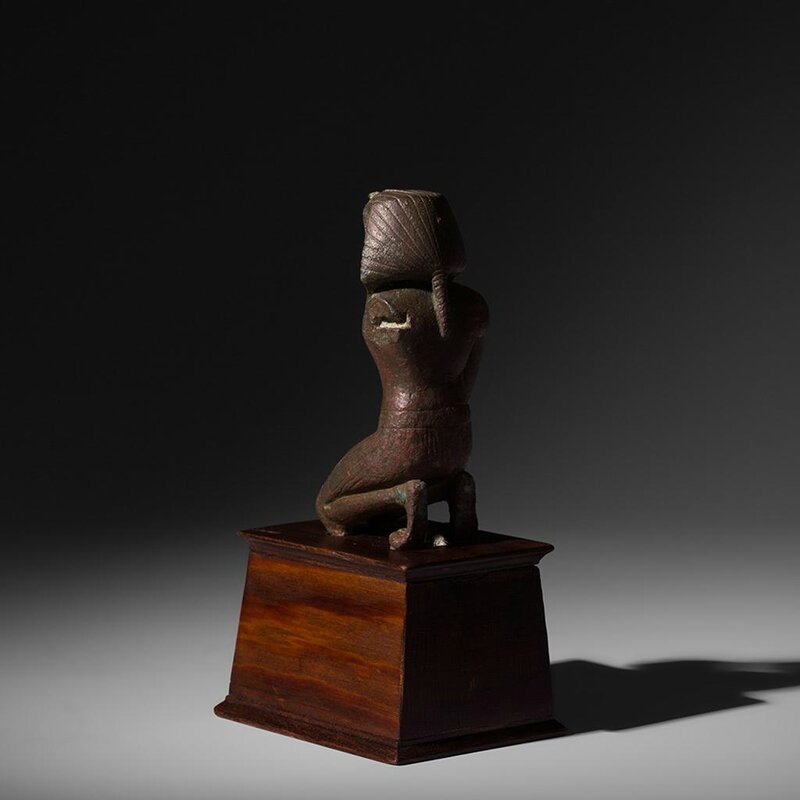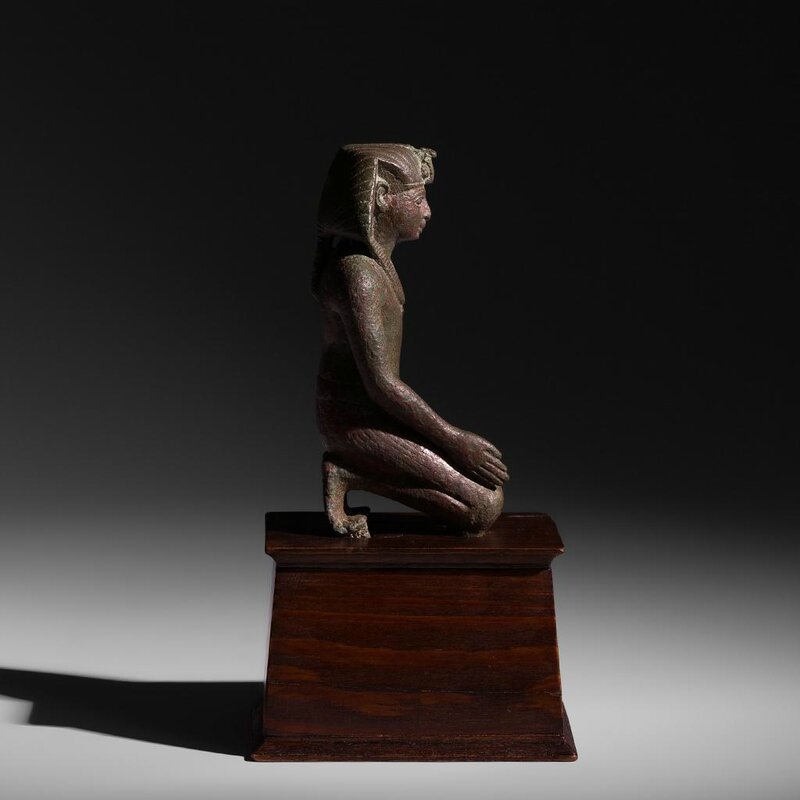Pharaoh, Ancient Egypt, Third Intermediate Period, Dynasties XXI - XXII, c. 1050 - 700 BC
Pharaoh, Ancient Egypt, Third Intermediate Period, Dynasties XXI - XXII, c. 1050 - 700 BC. Bronze. Height 10.5 cm (12.1 cm with pegs). Bagot Arqueología - Ancient Art at Brafa Art Fair, Brussels, 21-29 january 2017.
A noble solid bronze figure of a pharaoh making an offering. He is seen in a common pose in the typological repertory of this sort of statuary. Usually such a figure would be positioned in front of one on a larger scale, a figure of the principal deity of the temple where the pieces were to be placed.
The monarch is kneeling with the knees on the ground and the feet toward the back, giving a sense of balance to the upright torso and head. The right arm lies parallel to the body, resting on the thigh and with the palm of the hand open and extended forwards. The left arm is lost but this allows the manner of production of the piece to be understood. The arms were fabricated separately and inserted into the shoulders with a system of box and pin joints. This technique began with early copper sculptures, of which some few are still in existence, and it became popular with the first bronze figures made during the New Kingdom.
The head has perhaps a rather infantile appearance as it is on the large side when compared to the torso, and this is accentuated by the “Nemes” headdress, that of Egyptian royalty. This is a striped headcloth which totally covers the head apart from the face and the ears. It falls vertically behind the ears and is tied at the back in a knot near the nape of the neck as if it were a plait, and is divided into vertical and horizontal stripes. The last part of the headdress is the uraeus, the image of the goddess Wadjet, in the form of a cobra in an upright position, a clear symbol of protection. The face, with handsome, delicate features, and the ears alone are uncovered. These facial features, along with the technique used to set the arms in place, allow us to place the production of the piece in the Third Intermediate Period. We see a depiction somewhere between the serious, elegant, even majestic faces tending towards realism in the physiognomies at the time of the New Kingdom, and the extremely impersonal depictions of poor quality, of the Late Period.
The pharaoh, as in all representations of the Old and New Kingdom, is characteristically depicted with a solid chest and a thinner waist, which was the idealized state for a young, healthy man. The sculptor or craftsman, given that the role of the artist did not exist at that time, has marked out both the nipples and the navel. The pharaoh is wearing a pleated kilt tied at the waist. Four appendages or pegs are attached, two each at the knees and the feet, so that the figure can be attached and held in place correctly on the base. This was probably made of wood or bronze.
Although these small bronze sculptures of kings in this particular position first appear in the New Kingdom, a greater number of them were produced in the Third Intermediate Period. This suggests a greater attention to the subordinate role of the pharaoh to the gods, which is reflected in the religious philosophy. As the power of the king was no longer the same as in the first great kingdom, he became subject to the will of the gods.
The technique of lost wax casting is a sculptural procedure using a mould made from a prototype of the piece to be worked, and this prototype is usually made from beeswax. This is covered with a thick layer of soft material, usually clay, which then solidifies. Once this has hardened it is put in a kiln where the wax inside melts and leaks out through expressly made holes in the clay. In its place molten metal is injected and this takes on the exact form of the mould. To release the final piece the mould must be removed.
Provenance: Old collection of G.S., Holland, established in the 1960s
Bagot Arqueología - Ancient Art - Classical and Egyptian Antiquities. Consell de Cent 278, 08007 Barcelona, Spain

/https%3A%2F%2Fprofilepics.canalblog.com%2Fprofilepics%2F1%2F0%2F100183.jpg)
/https%3A%2F%2Fstorage.canalblog.com%2F03%2F02%2F119589%2F96711876_o.jpg)
/https%3A%2F%2Fstorage.canalblog.com%2F11%2F31%2F119589%2F94773502_o.jpg)
/https%3A%2F%2Fstorage.canalblog.com%2F20%2F83%2F119589%2F94772815_o.jpg)
/https%3A%2F%2Fstorage.canalblog.com%2F26%2F72%2F119589%2F75604929_o.jpg)
/https%3A%2F%2Fstorage.canalblog.com%2F59%2F60%2F119589%2F26458628_o.jpg)







/http%3A%2F%2Fstorage.canalblog.com%2F74%2F33%2F119589%2F72763120_o.jpg)
/http%3A%2F%2Fstorage.canalblog.com%2F41%2F09%2F119589%2F71183938_o.jpg)
/http%3A%2F%2Fstorage.canalblog.com%2F97%2F69%2F119589%2F33920816_o.jpg)
/http%3A%2F%2Fstorage.canalblog.com%2F86%2F66%2F119589%2F30468903_o.jpg)